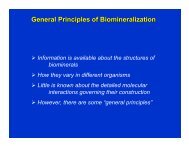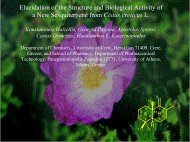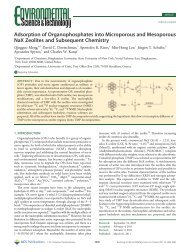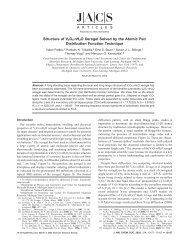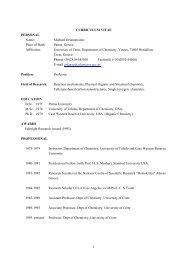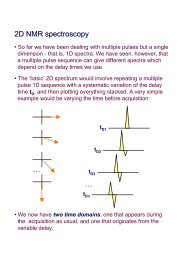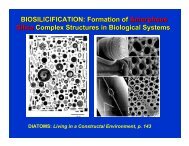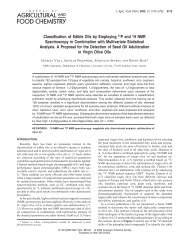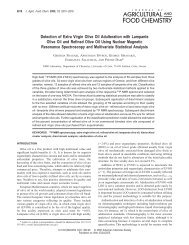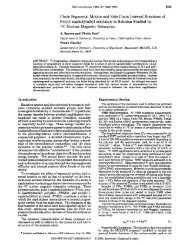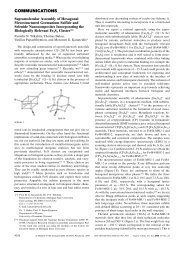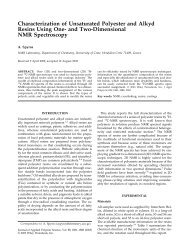Kenichi Fukui - Nobel Lecture - Nobelprize.org
Kenichi Fukui - Nobel Lecture - Nobelprize.org
Kenichi Fukui - Nobel Lecture - Nobelprize.org
You also want an ePaper? Increase the reach of your titles
YUMPU automatically turns print PDFs into web optimized ePapers that Google loves.
10 Chemistry 1981When the magnitude of electron density is adopted as the criterion theelectrostatic attraction and repulsion caused by the electron density are takeninto account. Therefore, it is reasonable to infer that an electrophilic reagentwill attack the position of large electron density in a molecule while a nucleophilicreaction will occur at the site of small electron density. In fact, Whelandand Pauling 3 explained the orientation of aromatic substitutions in substitutedbenzenes along these lines, and theoretical interpretations of the mode of manyother chemical reactions followed in the same fashion.However, the question why one of the simple reactions known from longbefore, the electrophilic substitution in naphthalene, for instance, such asnitration, yields α-substituted derivatives predominantly was not so easy toanswer. That was because, in many of such unsubstituted aromatic hydrocarbons,both the electrophile and the nucleophile react at the same location. Thispoint threw some doubt on the theory of <strong>org</strong>anic reactivity, where the electrondensity was thought to do everything.THE CONCEPT OF FRONTIER ORBITAIL INTERACTIONSThe interpretation of this problem was attempted by many people from variousdifferent angles. Above all, Coulson and Longuet-Higgins 4 took up thechange of electron density distribution under the influence of approachingreagent. The explanation by Wheland 5 was based on the calculation of theenergy required to localize electrons forcibly to the site of reaction. But I myselftried to attack this problem in a way which was at that time slightly unusual,Taking notice of the principal role played by the valence electrons in the case ofthe molecule formation from atoms, only the distribution of the electronsoccupying the highest energy π orbital of aromatic hydrocarbons was calculated.The attempt resulted in a better success than expected, obtaining an almostperfect agreement between the actual position of electrophilic attack and thesite of large density of these specified electrons as exemplified in Fig. 1. 6Fig. 1. Nitration of naphthalene.
K. <strong>Fukui</strong> 11The “orbital” concept, which was established and developed by manyscientists, such as Pauling, Slater, Mulliken, Roothaan, Löwdin, Hückel, Parrand so on, had till then been employed to construct the wave function of amolecule, through which molecular properties were usually interpreted. 7 Itseemed that the electron distribution in an orbital was directly connected tochemical observations and this fact was certainly felt to be interesting by manychemists.But the results of such a rather “extravagant” attempt was by no meanssmoothly accepted by the general public of chemists. That paper received anumber of controversial comments. This was in a sense understandable, because,for lack of my experiential ability, the theoretical foundation for thisconspicuous result was obscure or rather improperly given. However, it wasfortunate for me that the paper on the charge-transfer complex of Mullikenwas published in the same year as ours.The model of Mulliken et al. for protonated benzene was a good help. 9 Ourwork in collaboration with Yonezawa, Nagata and Kato provided a simple andpointed picture of theoretical interpretation of reactions,” as well as the“overlap and orientation” principle proposed by Mulliken with regard to theorientation in molecular complexes. 11 Subsequent to the electrophilic substitution,the nucleophilic substitution was discussed and it was found that inthis case the lowest energy vacant orbital played this particular part. 12 Inreactions with radicals, both of the two orbitals mentioned above, becamethe particular orbitals.There was no essential reason to limit these particular orbitals to π orbitals,so that this method was properly applied not only to unsaturated compoundsbut also to saturated compounds. The applicability to saturated compoundswas a substantial advantage in comparison with many theories of reactivitywhich were then available only for π electron compounds. The method displayedits particular usefulness in the hydrogen abstraction by radicals fromparaffinic hydrocarbons, the S N2 and E2 reactions in halogenated hydrocarbons,the nucleophilic abstraction of α−hydrogen of olefins, and so forth -13These two particular orbitals, which act as the essential part in a wide rangeof chemical reactions of various compounds, saturated or unsaturated, werereferred to under the general term of “frontier orbitals”, and abbreviatedfrequently by HOMO (highest occupied molecular orbital) and LUMO (lowestunoccupied molecular orbital).In this way, the validity of the theory became gradually clearer. The vein ofore discovered by chance was found to be hopefully more extensive thanexpected. But it was attributed to the role of the symmetry of particular orbitalspointed out in 1964 with regard to Diels-Alder reactions 14 that the utility ofour studies was further broadened. It was remarked that as is seen in Fig. 2, thesymmetries of HOMO and LUMO of dienes and those of LUMO and HOMOof dienophiles, respectively, were found to be in a situation extremely favourablefor a concerted cyclic interaction between them.This signified the following important aspects: First, it pointed out a possiblecorrelation between the orbital symmetry and the rule determining the sub-
Chemistry 1981stantial occurrence or non-occurrence of a chemical reaction, which may becalled the “selection rule”, in common with the selection rule in molecularspectroscopy. Second, it provided a clue to discuss the question concerningwhat was the “concertedness” in a reaction which forms a cycle of electrons inconjugation along the way.In 1965 Woodward and Hoffmann proposed the stereoselection rules whichare established today as the “Woodward-Hoffmann” rules. 15,16 An experimentalresult developed in Havinga’s important paper” was extended immensely.It is only after the remarkable appearance of the brilliant work byWoodward and Hoffmann that I have become fully aware that not only thedensity distribution but also the nodal property of the particular orbitals havesignificance in such a wide variety of chemical reactions. In fact, we studiedpreviously the noted (4n+2) rule proposed by Hückel 18 and noticed that thesign of the bond order in the highest energy electron orbital of an open-chainconjugation should be closely related to the stabilization of the correspondingconjugated rings. 19We did not imagine, however, on that occasion that thediscussion might be extended to the so-called Mobius-type ring-closure! 20
K. <strong>Fukui</strong> 13By considering the HOMO-LUMO interactions between the fragments of aconjugated chain divided into parts, 21the frontier orbital theory can yieldselection rules which are absolutely equivalent to those obtained from theprinciple called “the conservation of orbital symmetry” by Woodward andHoffmann. One point that I may stress here is, as was pointed out by Fujimoto,22Inagaki and myself, that the electron delocalization between the particularorbitals interprets definitely in terms of orbital symmetries the formation andbreaking of chemical bonds which, I believe, should be a key for perceivingchemical reaction processes.In the cycloaddition of butadiene and ethylene shown in Fig. 2, both theinteraction between the HOMO of diene and the LUMO of dienophile andthat between the LUMO of diene and the HOMO of dienophile stabilize theinteracting system. If one is interested in the local property of interaction,however, one may recognize the clear distinction between the roles of the twotypes of orbital interactions. The HOMO of ethylene and the LUMO ofbutadiene are both symmetric with regards to the symmetry plane retainedthroughout the course of cycloaddition. This signifies that each of the carbonatoms of ethylene are bound to both of the terminal carbons of butadiene. Thechemical bonding between the diene and dienophile thus generated may besomething like the one in a loosely bound complex, e.g., protonation to anolelinic double bond. On the contrary, the HOMO of butadiene and theLUMO of ethylene are antisymmetric. The interaction between these orbitalsleads, therefore, to two separated chemical bonds, each of which combines acarbon atom of ethylene and a terminal carbon atom of butadiene. Needless tosay it is the interaction between the HOMO of diene and the LUMO ofdienophile that is of importance for the occurrence of concerted cycloaddition.22In this way, it turned out in the course of time that the electron delocalizationbetween HOMO and LUMO generally became the principal factor determiningthe easiness of a chemical reaction and the stereoselective path, irrespectiveof intra- and intermolecular processes, as illustrated in Fig. 3. Besidesour own school, a number of other chemists made contributions. I want to referto several names which are worthy of special mention.First of all, the general perturbation theory of the HOMO-LUMO interactionbetween two molecules was built up by Salem. 23-25 One of Salem’spapers 25 was in line with the important theory of Bader, 26 which specified themode of decomposition of a molecule or a transition complex by means of thesymmetry of the normal vibration. Furthermore Pearson 27 investigated therelation between the symmetry of reaction coordinates in general and that ofHOMO and LUMO.The discussion so far may seem to be an overestimation of these selectedorbitals, HOMO and LUMO. This point was ingeniously modified by Klopman.28 He carefully took into account the factors to be considered in theperturbation theory of reacting systems and classified reactions into two cases:the one was “frontier-controlled” case in which the reaction was controlled bythe particular orbital interaction, and the other was the “charge-controlled”
14 Chemistry 1981Fig. 3. The mode of interaction between orbitals of two moleculescase, where it was controlled by the electrostatic interaction of charges. Thisclassification was conveniently used by many people. In this context the reviewarticles of Herndon 29 and of Hudson 30appeared to be very useful. The namesof Coulson 4 and Dewar 31 should also be noted here as those who contributedto the development of reactivity theories.Returning to the subject again, let us assume that two molecules approacheach other and orbital overlapping takes place. The perturbation theory 32 ofthis sort of interaction indicates that, the larger the orbital overlapping is andthe smaller the level separation of two overlapping orbitals is, the larger is thecontribution of the orbital pair to the stabilization of an interacting system.Accordingly, at least at the beginning, a reaction will proceed with a mutualnuclear configuration which is most favourable for the HOMO-LUMO overlapping.Now let us suppose an electron flow from the HOMO of molecule I to theLUMO of molecule II. In each molecule the bonds between the reactioncentre - the place at which the orbitals overlap with those of the other molecule- and the remaining part of the molecule are weakened. On this occasion,in molecule I the bonds which are bonding in HOMO are weakened and those
K. <strong>Fukui</strong> 15antibonding in HOMO are strengthened, while in molecule II the bonds whichare antibonding in LUMO are weakened and those bonding in LUMO arestrengthened. Consequently, the HOMO of molecule I particularly destabilizesas compared with the other occupied orbitals, and the LUMO of moleculeII discriminatively stabilizes among unoccupied orbitals, so that the HOMO-LUMO level separation between the two molecules is decreased. Such acircumstance is clearly understandable in Fig. 3.The following tendency is further stressed. When the bond weakeningsspecified above have arisen, the HOMO and the LUMO tend to become morelocalized at these weakened bonds in each molecule. Besides, the weakening ofthe bonds between the reaction centre and the remaining part causes anincrease of the amplitudes of HOMO and LUMO at the reaction centres,resulting in a larger overlapping of HOMO and LUMO. 33 Such a trend of thecharacteristic change in the orbital pattern is made numerically certain byactual calculations. The role of interaction between HOMO and LUMO turnsout in this way to become more and more important as the reaction proceeds.A series of studies on chemical interactions were attempted in which theinteraction of reactants was divided into the Coulomb, the exchange, thepolarization, and the delocalization interactions, and their magnitude of contributionto the interaction energy was quantitatively discussed .32,34 The interactionsdiscussed by this method were the dimerization 35 and the addition toethylene 36of methylene and the dimerization of BH 3, 37 and also severaldonor-acceptor interactions-BH 3-NH 3, 38 BH 3-CO, 39 NH 3-HF, 40 etc. Themethod was applied also to reactions of radicals, such as the abstraction of amethane hydrogen by methyl radical, the addition of methyl radical to ethylene41 and recombinations, disproportionations, and self-reactions of two radicals.42 In these calculations, the configuration analysis proposed originally byBaba 43 was also utilized conveniently. We could show numerically the mode ofincrease of the electron delocalization from HOMO to LUMO along with theproceeding of reaction, the increasing weight of contribution of such a delocalizationto the stabilization of the reacting system, the driving force of thereaction in terms of orbital interactions, and so on.The question “Why HOMO and LUMO solely determine the reactionpath?” was one which I very frequently received from the audiences in mylectures given in the past in different places. The discussion so far made here isthought to correspond, at least partly, to that answer. But one may not adhereso strictly to the HOMO and LUMO. In one-centre reactions like substitutions,which the orbital symmetry has nothing to do with, any occupied orbitalswhich are very close to HOMO should properly be taken into account. 12 Inlarge paraffin molecules a number of HOMO’s (high-lying occupied MO’s),and furthermore as will shortly be referred to later, in metal crystals, even“HOMO-band” must be taken along the line of reactivity argument. IfHOMO or LUMO happens to be inadequate owing to its extension, thesymmetry, or the nodal property, the next orbital should be sought for. One ofthe simplest examples of such an instance is the protonation of pyridine. In thiscase, the nitrogen lone-pair orbital is not HOMO, but the addition of proton to
16 Chemistry 1981the nitrogen lone-pair so as not to disturb the π conjugation will evidently bemore advantageous than the addition to higher occupied π orbitals which mayintercept the π conjugation. Thus, the reason why proton dare not add to thepositions of large amplitude of π HOMO in this case will easily be understood.It is not completely satisfactory to dispose of a disagreement between theHOMO-LUMO argument and the experimental fact formally as an exception tothe theory. A so-called exception does possess its own reason. To investigatewhat the reason is will possibly yield a novel finding.The HOMO-LUMO interaction argument was recently pointed out 44 to bein an auxiliary sense useful for the interpretation of the sign of a reactionconstant and the scale of a substituent constant in the Hammett rule 45 whichhas made an immeasurable contribution to the study of the substituent effect inchemical reactivity. In the cyclic addition, like Diels-Alder reactions and 1,3-dipolar additions, the relative easiness of occurrence of reactions, varioussubsidiary effects, and interesting phenomena like regioselection and periselectionwere interpreted with considerable success simply by the knowledge of theheight of the energy level of HOMO and LUMO, the mode of their extension,their nodal structure, etc. 46- I defined these in a mass: the "orbital pattern".Other topics that have been discussed in terms of HOMO-LUMO interactionsare thermal formation of excited states, 47 singlet-triplet selectivity, 48 thechemical property of biradicals and excited molecules, 49 the interaction of thecentral atom and ligands in transition metal complexes, 50 the interaction ofthree or more orbitals 51 and so forth. Inagaki et al. included in the theory thepolarization effect in HOMO and LUMO due to the mixing in of other orbitalsand gave an elucidation for a number of <strong>org</strong>anic chemical problems which werenot always easy to explain. The unique stereoselection in the transannularcross-bond formation, the lone-pair effect, the d orbital effect, and the orbitalpolarization effect due to substituents were the cases. 52As was partly discussed above, the method of orbital interaction was appliednot only to the ground electronic state but to the excited states, giving anexplanation of the path of even complicated photochemical isomerizations. 1321In a majority of cases the HOMO and the LUMO of the ground-statemolecule were also found to be the essential orbitals. Even the ground-statereaction of a strong electron acceptor (or donor) causes a mixing in of anionized electron configuration or an excited electron configuration in anothermolecule. In consequence, a partial HOMO-HOMO or LUMO-LUMO interaction,which would be trivial if there were no influence of the acceptor (ordonor), becomes important in stabilizing the interacting system.*’The problems so far discussed have been limited to chemical reactions.However, the HOMO-LUMO interaction must come into relation also withother chemical phenomena in almost the same mechanism - with the exceptionof one different point that they usually do not bring about so remarkable achange in the nuclear configuration as in the case of chemical reactions. NOWlet us examine the possibility of applying the theory to so-called “aromaticity”-one of the simplest, but the hardest-to-interpret problems. There seemto be few problems so annoying to theoreticians as the explanation of this
K. <strong>Fukui</strong> 17chemically classical concept. I greatly appreciate the contribution of Dewar’s53, 54theory based on a quantitative energy values argument. Here, however, Iwant to give a quality comment through a totally different way of consideration.It is easilyascertained55in Fig. 4 that in benzene, naphthalene, phenanthrene,etc., any virtual division of the molecule into two always produces theparts in which their HOMO and LUMO overlap in-phase at the two junctions.Fig. 4. The HOMO-LUMO phase relationship in virtual division of aromatic hydrocarbons.(SOMO: a singly occupied MO of a radical)
18 Chemistry 1981But these circumstances are not seen in anthracene which is usually lookedupon as one of the typical representatives of aromatic compounds. Hosoya 55pointed out from the comparison with phenanthrene indicated in Fig. 4, thatthe ring growth of type (II) was less stable than that of (I),It is well known that anthracene occasionally exhibits a reactivity of olefin-likeadditions.In view of so-called Hückel’s (4n+2)-rule mentioned above, an anthracenemolecule has 14π electrons and fulfils the stability condition for “aromaticity.”Actually, if one considers a molecule of anthracene with the two inside bondsdeleted,it is really seen that the HOMO and the LUMO of the two parts overlap in anin-phase manner at both of the junctions:In this way, it is understood that the two bonds which were deleted aboveexerted a certain unfavourable influence for aromaticity. Such an influencebears a close resemblance to that of impurity scattering in the wave of a freeelectron moving in a metal crystal.This discussion seems to be a digression but, as a matter of fact, it relates tothe essential question as to how an electron in a molecule can delocalize. As willbe mentioned later, Anderson 56solved the question how an electron in a
K. <strong>Fukui</strong> 19random system can localize. In a molecule, there are potential barriers betweenatoms which should be got over by the aid of a certain condition to be satisfied,in order for an electron to move around it freely. Although the question howvalence electrons can delocalize in a molecule have not yet been solvedsatisfactorily under the condition of unfixed nuclear configuration, the in-phaserelation of HOMO and LUMO at the junctions of the two parts of themolecule seems to be at least one of the conditions of intramolecular delocalizationof electrons.Generally speaking, the electron delocalization gives rise to a stabilizationdue to “conjugation” which is one of the old chemical concepts. If so, similarstabilization mechanisms must be chemically detected in other systems thanaromatic compounds. The discussion of this delocalization stabilization at thetransition state or on the reaction path was nothing but the reactivity theoryhitherto mentioned. The term “delocalizability” was attached to the reactivityindices we derived,” and our reactivity theory itself was sometimes called“delocalization approach.“ 14 The “hyperconjugation” of various sorts is explainedin the same manner. The stabilization due to homoaromaticity orbicycloaromaticity of Goldstein, 57 the stability in spirocycles, pericycles, 58“laticycles” and “longicycles” of Hoffmann and Goldstein, 59 that of spirarenesof Hoffmann and Imamura, 60and so on, are all comprehended as examples ofthe stabilization due to the delocalization between HOMO and LUMO,although other explanations may also be possible.You may be doubtful to what extent such a qualitative consideration isreliable. In many cases, however, a considerably accurate nonempirical determinationof the stable conformation of hydrocarbon molecules 61, 62 results in aconclusion qualitatively not much different from the expectation based on thesimple orbital interaction argument mentioned above.CHEMICAL REACTION PATHWAYSIt has already been pointed out that the detailed mechanism of a chemicalreaction was discussed along the reaction path on the basis of the orbitalinteraction argument. For that purpose, however, it is required that the problemas to how the chemical reaction path is determined should have beensolved. The method in which the route of a chemical reaction was supposed onthe potential energy surface and the rate of the reaction was evaluated by theaid of a statistical-mechanical formulation was established by Eyring. 63 Manypeople wrote papers where the rate expression was derived wave-mechanicallywith the use of the potential energy function. Besides, the problem of obtainingthe trajectory of a given chemical reaction with a given initial condition wastreated by Karplus. 64The centre line of the reaction path, so to speak, the idealized reactioncoordinate - which I called “intrinsic reaction coordinate” (IRC) 65 - seemedto have been, rather strangely, not distinctly defined till then. For that reason, Ibegan with the general equation which determines the line of force mathemat-
20 Chemistry 1981ically.34, 66, 67Al t h oughmy papers themselves were possibly not veryoriginal, they turned out later to develop in a very interesting direction. 68-74These papers opened the route to calculate the quasistatic change of nuclearconfiguration of the reacting system which starts from the transition stateproceeding to a stable equilibrium point. 66 I termed the method of automaticdetermination of the molecular deformation accompanying a chemical reaction34 67as “reaction ergodography.” This method was applied to a few definiteexamples by Kato and myself 67 and by Morokuma. 72, 73 Those exampleswere: abstraction and substitution of methane hydrogen by hydrogen atom, 67nucleophilic replacement in methane by hydride anion, 72 and isomerization ofmethylcarbylamine to acetonitrile. 73 All of these reactions thus far treated arelimited to the simplest cases, but there seems to be no principal difficulty inextending the applicability to larger systems. Once IRC was determined in thisway, the driving force of a chemical reaction was analyzed on the basis of theorbital interaction argument. 66In the reacting system with no angular momentum it is possible to obtain theIRC by the use of the space-fixed Cartesian coordinate system. All of thecalculated examples mentioned above belong to this case. However, in thereaction in which rotational motion exists, it is required to discuss the IRCafter separating the nuclear configuration space from the rotational motion. 74-77For that purpose, it is essential to derive the general classical Hamiltonian ofthe reacting systems and then to separate the internal motion which is determinedonly by the internal coordinates. The nuclear configuration space thusseparated out is in general a Riemannian space. The classical Lagrangian formto be obtained in that process of constructing the Hamiltonian is used to deriyethe IRC equation in the presence of rotational motion. It is thus understoodthat the rotational motion of the reacting system generally causes a deviation ofIRC. 74Once the method of determining unique reaction pathways is obtained, thenext problem we are concerned with is to see if the calculated pathways areinterpreted in terms of the frontier orbital interactions. A method referred to asthe “interaction frontier orbitals” or “hybrid molecular orbitals” has beendeveloped very recently by Fujimoto and myself in order to furnish a lucidscheme of frontier orbital interactions with the accuracy of nonempirical calculationsnow and in the future. 78-80 By including properly contributions of otherMOs than the HOMO and the LUMO, we realized in terms of orbitaldiagrams how ingenious the empirically established chemical concepts - “reactionsites” and “functional groups”-and the empirical concept of reactionpathways could be. Fig. 5 compares the HOMO of styrene and its interactionfrontier orbital for protonation to the olelinic double bond. The latter is seen tobe localized very efficiently in the frontier of chemical interaction. The doublebond is evidently the functional unit in this case. Innovation of the frontierorbital concept will hopefully be continued by young people to make it usefulfor one of our ultimate targets: theroretical design of molecules and chemicalreactions.
K <strong>Fukui</strong> 21Fig. 5. A comparison of HOMO and the interaction frontier orbital for protonation in styrene.FRONTIER ORBITALS IN RELATED FIELDSTheoretical treatments of the property of solid crystals, or chemisorption on asolid surface, appear to have hitherto been almost monopolistically treated bythe methodology of physics. But the orbital pattern technique has also advancedgradually in this field.The “cluster approach, ” 81, 82 in which a portion of the metal crystal isdrawn out as the form of a cluster of atoms and its catalytic actions or otherproperties are investigated, has contributed to the development of the orbitalpattern approach, because the physical methods mentioned above can hardlybe applied to such sizable systems. It is expected that, if clusters of various sizesand various shapes are studied to look into the characteristic feature of theirHOMO’s (high-lying occupied MO’s) and LUMO’s (low-lying unoccupiedMO’s), the nature of chemisorption and catalytic action, the mode of surfacechemical reaction, and several related subjects of interest can be investigatedtheoretically.As is the case of molecular interactions in usual chemical reactions, only theHOMO- and LUMO-bands lying in the range of several electron volts near theFermi level can participate in the adsorption of molecules and surface reactionson solid crystals. You may recollect here that, in the BCS (Bardeen-Cooper-Schrieffer) theory of superconductivity, too, only the HOMO’s and LUMO’sin close proximity to the Fermi surface can be concerned in forming electronpairs as the result of interaction with lattice vibration. In the case of solidcatalysts mentioned above, the discrimination of particular orbitals and electronsfrom the others have made the situation much easier.Consider a system composed of a regular repetition of a molecular unit, forinstance, a one-dimensional high polymer chain or a one-dimensional lattice, inwhich a certain perturbation is imposed at a definite location. Sometimes it isconvenient to discuss the influence of this perturbation by transforming the
22 Chemistry 1981orbitals belonging to the HOMO-band to construct the orbitals localized atthat place. One such technique was proposed by Tanaka, Yamabe and myself.83 This method is expected to be in principle applied to a local discussionof such problems as the adsorption of a molecule on the two-dimensionalsurface of catalysts, surface reactions, and related matters. This approach maybe called a little more chemical than the method using the function of localdensity of states 84or similar ones, in that the former can be used for theargument of the reactivity of molecules on a catalyst surface in terms of thephase relationship of localized orbitals.What is called low-dimensional semiconductors and some superconductorshave also been the objects of application of the orbital argument. In these85studies, the dimerization of S 2N 2to S 4N 4and the high-polymerization to86(SN) xwere discussed, and the energy band structure of (SN) xpolymer chainwas analyzed to investigate the stable nuclear arrangement and the mode ofinter-chain interactions. 87The modern technique employed in solid state physics to interpret theinteresting characteristic behaviours of noncrystalline materials, in particularof amorphous materials, in which the nuclear arrangements were not regular,was certainly striking. Anderson showed generally that in a system of randomlattice the electron localization should take place. 56 Mott, stating in his 1977<strong>Nobel</strong> lecture that he thought is the first prize awarded for the study ofamorphous materials, answered the question, “How can a localized electron beconducted?” with the use of the idea of hopping. Here, too, the HOMO-LUMO interaction - in this case the consideration of spin is essential - wouldplay an important part.Here in a few words, I want to refer to the meaning and the role of virtualorbitals. The LUMO, which has been one of the stars in orbital argumentshitherto discussed, is the virtual orbital which an external electron is consideredto occupy to be captured by a molecule to form an anion. Virtual orbitalsalways play an essential part in producing metastable states of molecules byelectron capture. 88 To discuss such problems generally, Tachibana et al. 89systematized the theory of resonant states from the standpoint of complexeigenvalue problem. The idea of resonant states will take a principal part inchemical reactions, particularly in high-energy reactions which will be developedmore in the future.PROSPECTIn introducing above a series of recent results of the studies carried out mainlyby our group, I have ventured to make those things the object of my talk whichare no more than my prospective insight and are not yet completely established.This is just to stimulate, by specifying what are the fields I believepromising in the future, the intentional efforts of many younger chemists inorder to develop them further.In my opinion, quantum mechanics has two different ways of making participationsin chemistry. One is the contribution to the nonempirical comprehen-
K. <strong>Fukui</strong> 23sion of empirical chemical results just mentioned. However, we should notoverlook another important aspect of quantum mechanics in chemistry. That isthe promotion of empirical chemistry from the theoretical side. But, also forthis second purpose, as a matter of course, reliable theoretical foundations andcomputational methods are required. The conclusions of theories should belittle affected by the degree of sophistication in approximations adopted.On the other hand, for theoreticians to make the second contribution, thecases where predictions surpassing the experimental accuracy are possible byvery accurate calculations are for the present limited to those of a very few,extremely simple molecules. In order to accomplish this object in regard toordinary chemical problems, it becomes sometimes necessary to provide qualitativetheories which can be used even by experimental chemists. If one cancontribute nothing to chemistry without carrying out accurate calculationswith respect to each problem, one can not be said to be making the most ofquantum mechanics for the development of chemistry. It is certainly best thatthe underlying concepts are as close to experience as possible, but the sphere ofchemical experience is steadily expanding. Quantum chemistry has then toperform its duty by furnishing those concepts with the theoretical basis in orderto make them chemically available and serviceable for the aim of promotingempirical chemistry.Even the same atoms of the same element, when they exist in differentmolecules, exhibit different behaviours. The chemical symbol H even seems tosignify atoms of a completely different nature. In chemistry, this terribleindividuality should never be avoided by “averaging,” and, moreover, innumerablecombinations of such atoms form the subject of chemical research,where it is not the “whole assembly of compounds of different kinds but eachindividual kind of compounds” that is of chemical interest. On account of thisformidable complexity, chemistry possesses inevitably one aspect of dependingon the analogy through experience. This is in a sense said to be the fate allotedto chemistry, and the source of a great difference in character from physics.Quantum chemistry, too, so far as it is chemistry, is required to be useful inpromoting empirical chemistry as mentioned before.ACKNOWLEDGEMENTSLastly, I want to mention at this opportunity out of a sense of gratefulness thenames of many people in our group who have been walking on the same road asmine since my first paper (1952) on quantum chemistry, particularly Drs. T.Yonezawa, C. Nagata, H. Kato, A. Imamura, K. Morokuma, T. Yamabe andH. Fujimoto, and also I can not f<strong>org</strong>et the names of younger doctors mentionedin the text who made a contribution in opening new circumstances in eachfield. Among them, Prof. T. Yonezawa was helpful in performing calculationsin our 1952 paper, and also, it is to be mentioned with appreciation that theattractive title “frontier orbitals” of my lecture originated from the terminologyI adopted in that paper by the suggestion of Prof. H. Shingu, who kindlyparticipated in that paper as an <strong>org</strong>anic chemist to classify the relevant experi-
24 Chemistry 1981mental results. Furthermore, many other collaborators are now distinguishingthemselves in other important fields of chemistry, which, however, have notbeen the object of the present lecture.It was the late Prof. Yoshio Tanaka of the University of Tokyo and Prof.Masao Horio of Kyoto University who recognized the existence and significanceof my early work in advance to others. I owe such a theoretical work,which I was able to carry out in the Faculty of Engineering, Kyoto University,and moreover in the Department of Fuel Chemistry, to the encouragement andkind regard of Prof. Shinjiro Kodama, who fostered the Department. What ismore, it was the late Prof. Gen-itsu Kita, my life-teacher, and the founder of theDepartment, who made me enter into chemistry, one of the most attractive andpromising fields of science, and led me to devote my whole life to it. For all ofthese people no words of gratitude can by any means be sufficient.REFERENCESI. For instance, see Ingold, C. K., Structure and Mechanism in Organic Chemistry, CornellUniversity Press (1953), Ithaca, N.Y.2. For instance, see Lewis, G. N., Valence and the Structure of Atoms and Molecules, ChemicalCatalog Co. (1923), New York, N.Y.3. Wheland, G. W. and Pauling, L., J. Am. Chem Soc. 57, 2086 (1935).4. Coulson, C. A. and Longuet-Higgins, H. C., Proc. Roy. Soc. (London) A191, 39; A192, 16(1947).5. Wheland, G. W., J. Am. Chem. Soc. 64, 900 (1942).6. <strong>Fukui</strong>, K., Yonezawa, T. and Shingu, H., J. Chem. Phys. 20, 722 (1952).7. For instance, see Parr, R. G., The Quantum Theory of Molecular Electronic Structure,Benjamin (1963), New York, N.Y. and references cited therein.8. Mulliken, R. S., J. Am. Chem. Soc. 74, 811 (1952).9. Picket, L. W., Muller, N. and Mulliken, R. S., J. Chem. Phys. 21, 1400 (1953).10. <strong>Fukui</strong>, K., Yonezawa, T. and Nagata, C., Bull. Chem. Soc. Jpn. 27, 423 (1954); <strong>Fukui</strong>, K.,Kato, H. and Yonezawa, T., ibid. 34, 1112 (1961).11. Mulliken, R. S., Rec. Trav. Chim. 75, 845 (1956).12. <strong>Fukui</strong>, K., Yonezawa, T., Nagata, C. and Shingu, H., J. Chem. Phys. 22, 1433 (1954).13. For instance, see <strong>Fukui</strong>, K., Theory of Orientation and Stereoselection, Springer (1970),Berlin.14. <strong>Fukui</strong>, K. In: Molecular Orbitals in Chemistry, Physics and Biology, Löwdin, P.-O. andPullman, B. eds., Academic (1964), New York, N.Y., p. 513.15. Woodward, R. B. and Hoffmann, R., Angew. Chem. 81, 797 (1969); The Conservation ofOrbital Symmetry, Academic Press (1969), New York, N.Y.; see papers In: Orbital SymmetryPapers, Simmons, H. E. and Bunnett,J. F., eds., ACS (1974), Washington D.C.16. Woodward, R. B. and Hoffmann, R., J. Am. Chem. Soc. 87, 395 (1965).17. Havinga, E., de Kock, R. J. and Rappoldt, M. P., Tetrahedron 11, 276 (1960); Havinga, E. andSchlatmann, J. L. M. A., ibid. 15, 146 (1961).18. Hückel, E., Z. Phys. 70, 204 (1931); 76,628 (1932).19. <strong>Fukui</strong>, K., Imamura, A., Yonezawa, T. and Nagata, C., Bull. Chem. Soc. Japan 33, 1501(1960).20. Heilbronner, E., Tetrahedron Lett., 1964, 1923.21. <strong>Fukui</strong>, K., Acc. Chem. Res. 4, 57, (1971).22. Fujimoto, H., Inagaki, S. and <strong>Fukui</strong>, K., J. Am. Chem. Soc. 98,2670 (1976).23. Salem, L., J. Am. Chem. Soc. 90, 543, 553 (1968).24. Devaquet, A. and Salem, L., J. Am. Chem. Soc. 91, 3743 (1969).
K. <strong>Fukui</strong> 2525. Salem, L., Chem. Brit. 5,449 (1969).26. Bader, R. F. W., Can., J. Chem. 40, 1164 (1962).27. Pearson, R. G., Symmetry Rules for Chemical Reactions, John Wiley (1976), New York, N.Y.and references cited therein.28. Klopman, G., J. Am. Chem. Soc. 90, 223 (1968). Also see Klopman, G., Chemical Reactivityand Reaction Paths, John Wiley (1974), New York, N.Y.29. Herndon, W. C., Chem. Rev. 72, 157 (1972).30. Hudson, R. F., Angew. Chem. Int. Ed. Eng. 12,36 (1973).31. For instance, see Dewar, M. J. S. and Dougherty, R. C., The PMO Theory of OrganicChemistry, Plenum (1975), New York, N.Y. and many papers cited therein; see also Dewar,M. J. S., Thetrahedron S8, Part I, p. 85 (1966).32. <strong>Fukui</strong>, K. and Fujimoto, H., Bull. Chem. Soc. Japan 41, 1989 (1968).33. <strong>Fukui</strong>, K. and Fujimoto, H., Bull. Chem. Soc. Japan 42, 3392 (1969).34. <strong>Fukui</strong>, K. In: The World of Quantum Chemistry, Daudel, R. and Pullman, B. eds., Reidel(1974), Dordrecht, p. 113.35. Fujimoto, H., Yamabe, S. and <strong>Fukui</strong>, K., Bull. Chem. Soc. Japan 45, 1566 (1972).36. Fujimoto, H., Yamabe, S. and <strong>Fukui</strong>, K., Bull. Chem. Soc. Japan 45, 2424 (1972).37. Yamabe, S., Minato, T., Fujimoto, H. and <strong>Fukui</strong>, K., Theoret. Chim. Acta (Berl.) 32, 187(1974).38. Fujimoto, H., Kato, S., Yamabe, S. and <strong>Fukui</strong>, K., J. Chem. Phys. 60, 572 (1974).39. Kato, S., Fujimoto, H., Yamabe, S., <strong>Fukui</strong>, K., J. Am. Chem. Soc. 96, 2024 (1974).40. Yamabe, S., Kato, S., Fujimoto, H. and <strong>Fukui</strong>, K., Bull. Chem. Soc. Japan 46, 3619 (1973);Yamabe, S., Kato, S., Fujimoto, H. and <strong>Fukui</strong>, K., Theoret. Chim. Acta (Berl.) 30, 327 (1973).41. Fujimoto, H., Yamabe, S., Minato, T. and <strong>Fukui</strong>, K., J. Am. Chem. Soc. 94, 9205 (1972).42. Minato, T., Yamabe, S., Fujimoto, H. and <strong>Fukui</strong>, K., Bull. Chem. Soc. Japan 51, 1 (1978);Minato, T., Yamabe, S., Fujimoto, H. and <strong>Fukui</strong>, K., Bull. Chem. Soc. Japan 51, 682 (1978).43. Baba, H., Suzuki, S. and Takemura, T., J. Chem. Phys. 50, 2078 (1969).44. Henri-Rousseau, O. and Texier, F., J. Chem. Education 55,437 (1978).45. For instance, see Hammett, L. P., Physical Organic Chemistry, McGraw-Hill (1940), NewYork, N.Y.46. Houk, K. N., Acc. Chem. Res. 8, 361 (1975) and references cited therein.47. Inagaki, S., Fujimoto, H. and <strong>Fukui</strong>, K., J. Am. Chem. Soc. 97,6108 (1975).48. See Fleming, I., Frontier Orbitals and Organic Chemical Reactions, John Wiley (1976), NewYork, N.Y.; Gilchrist, T. L. and Storr, R. C., Organic Reactions and Orbital Symmetry,Cambridge Univ. Press, 2nd ed. (1979), London.49. <strong>Fukui</strong>, K. and Tanaka, K., Bull. Chem. Soc. Japan 50, 1391 (1977).50. <strong>Fukui</strong>, K. and Inagaki, S., J. Am. Chem. SOC. 97,4445 (1975) and many papers cited therein.51. Inagaki, S., Fujimoto, H. and <strong>Fukui</strong>, K., J. Am. Chem. Soc. 98,4693 (1976).52. Inagaki, S. and <strong>Fukui</strong>, K., Chem. Lett. 1974, 509; Inagaki, S., Fujimoto, H. and <strong>Fukui</strong>, K., J.Am. Chem. Soc. 98, 4054 (1976).53. Dewar, M. J. S., The Molecular Orbital Theory of Organic Chemistry, McGraw-Hill (1969),New York, N.Y.54. Dewar, M. J. S., Angew. Chem. 83,859 (1971).55. <strong>Fukui</strong>, K., Kagaku to Kogyo 29,556 (1976); Hosoya, H., Symposium on Electron Correlationin Molecules, Res. Inst. for Fund. Phys., Dec. 18, 1976.56. Anderson, P. W., Phys. Rev. 109, 1492 (1958); cf. 1977 <strong>Nobel</strong> <strong>Lecture</strong>s in Physics by Anderson,P. W., and by Mott, N. F.57. Goldstein, M. J., J. Am. Chem. Soc. 89,6357 (1967).58. Simmons, H. E. and Fukunaga, T., J. Am. Chem. Soc. 89, 5208 (1967).59. Goldstein, M. J. and Hoffmann”, R., J. Am. Chem. Soc. 93,6193 (1971).60. Hoffman”, R., Imamura, A. and Zeiss, G., J. Am. Chem. Soc. 89, 5215 (1967).61. For instance, see Hehre, W. J. and Pople, J. A., J. Am. Chem. Soc. 97,694l (1975).62. Hehre, W. J., Acc. Chem. Res. 8, 369 (1975).63. For instance, see Glasstone, S., Laider, K. J. and Eyring, H., The Theory of Rate Processes,McGraw-Hill (1941), New York, N.Y. and references cited therein.
26 Chemistry 198164. Wang, I. S. Y. and Karplus, M., J. Am. Chem. Soc. 95, 8060 (1973) and references citedtherein.65. <strong>Fukui</strong>, K., J. Phys. Chem. 74, 4161 (1970).66. <strong>Fukui</strong>, K., Kato, S. and Fujimoto, H., J. Am. Chem. Soc. 97, 1 (1975).67. Kato, S. and <strong>Fukui</strong>, K., J. Am. Chem. Soc.98,6395 (1976).68. Tachibana, A. and <strong>Fukui</strong>, K., Theoret. Chim. Acta (Berl.) 49, 321 (1978).69. Tachibana, A. and <strong>Fukui</strong>, K., Theoret. Chim. Acta (Berl.) 51, 189, 275 (1979).70. Tachibana, A. and <strong>Fukui</strong>, K., Theoret. Chim. Acta (Berl.) 5, (1979).71. <strong>Fukui</strong>, K., Rec. Trav. Chim., Pays-Bas 98, 75 (1979).72. Joshi, B. D. and Morokuma, K., J. Chem. Phys. 67,488O (1977).73. Ishida, K., Morokuma, K. and Komornicki, A., J. Chem. Phys. 66, 2153 (1977).74. <strong>Fukui</strong>, K., Tachibana, A. and Yamashita, K., Intern. J. Quant. Chem., Quant. Chem. Symp.15,621 (1981).75. Miller, W. H., Handy, N. C. and Adams, J. E., J. Chem. Phys. 72, 99 (1980); Gray, S. K.,Miller, W. H., Yamaguchi, Y. and Schaefer, H. F., III., ibid. 73, 2732 (1980).76. <strong>Fukui</strong>, K., Intern. J. Quant. Chem., Quant. Chem. Symp. 15,633 (1981).77. <strong>Fukui</strong>, K., Act. Chem. Res. 14, 363 (1981).78. <strong>Fukui</strong>, K., Koga, N. and Fujimoto, H., J. Am. Chem. Soc. 103, 196 (1981).79. Fujimoto, H., Koga, N., Endo, M. and <strong>Fukui</strong>, K., Tetrahedron Letters 22, 1263; 3427 (1981).80. Fujimoto, H., Koga, N. and <strong>Fukui</strong>, K., J. Am. Chem. Soc. 103, 7452 (1981).81. For instance, see Johnson, K. H. In: The New World of Quantum Chemistry, Pullman, B. andParr, R. G. eds., Reidel (1976), Dordrecht, p. 317 and references cited therein.82. Kobayashi, H., Kato, H., Tarama, K. and <strong>Fukui</strong>, K., J. Catalysis 49, 294 (1977); Kobayashi,H., Yoshida, S., Kato, H., <strong>Fukui</strong>, K. and Tarama, K., Surface Science 79, 189 (1979).83. Tanaka, K., Yamabe, T. and <strong>Fukui</strong>, K., Chem. Phys. Letters 48, 141 (1977).84. For instance, Schrieffer, J. R. In: The New World of Quantum Chemistry, Pullman, B. andParr, R. G. eds., Reidel, D., Dordrecht (1976), p. 305; Danese, J. B. and Schrieffer, J. R.,Intern. J. Quant. Chem., Quant. Chem. Symp. 10, 289 (1976).85. Tanaka, K., Yamabe, T., Noda, A., <strong>Fukui</strong>, K. and Kato, H., J. Phys. Chem. 82, 1453 (1978).86. Yamabe, T., Tanaka, K., <strong>Fukui</strong>, K. and Kato, H., J. Phys. Chem. 81, 727 (1977).87. Tanaka, K., Yamabe, T. and <strong>Fukui</strong>, K., Chem. Phys. Letters 53, 453 (1978).88. For instance, see Ishimaru, S., Yamabe, T., <strong>Fukui</strong>, K. and Kato, H., J. Phys. Chem. 78, 148(1974); Ishimaru, S., <strong>Fukui</strong>, K. and Kato, H., Theoret. Chim. Acta (Berl.) 39, 103 (1975).89. Tachibana, A., Yamabe, T. and <strong>Fukui</strong>, K., J. Phys. B. Atom. Molec. Phys. 10, 3175 (1977);Adv. Quant. Chem. II, 195 (1978).




